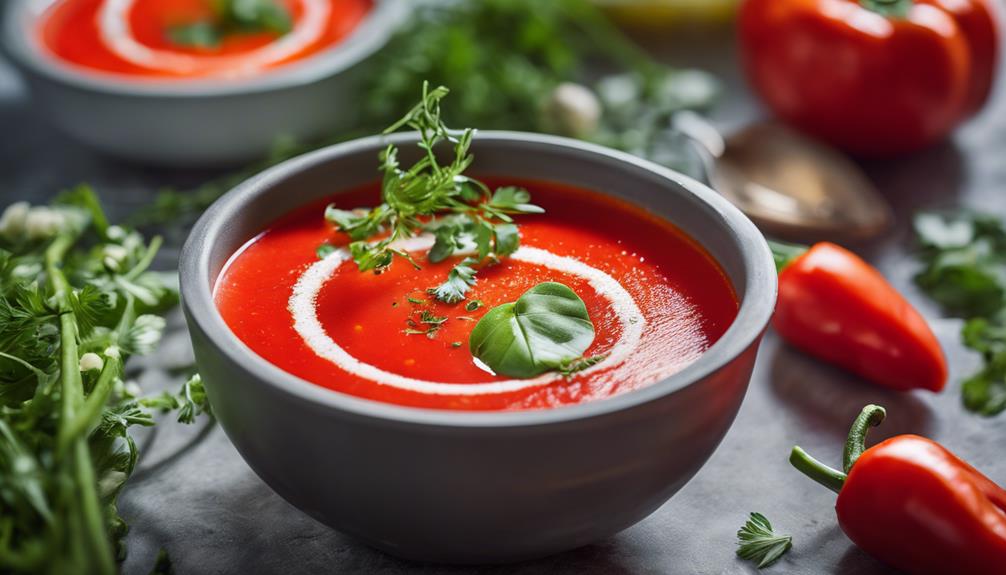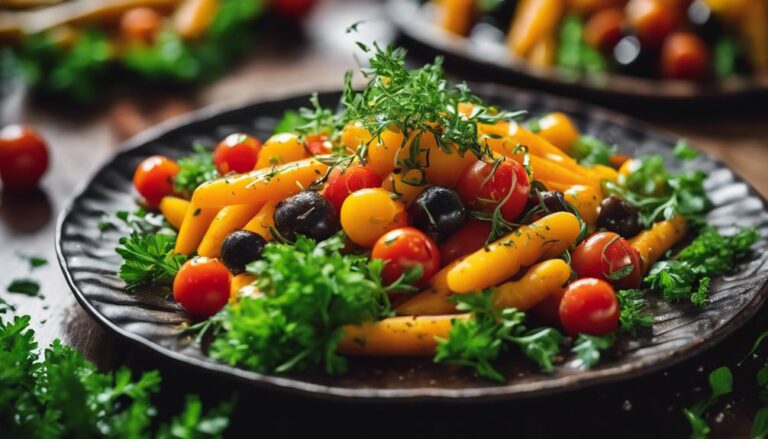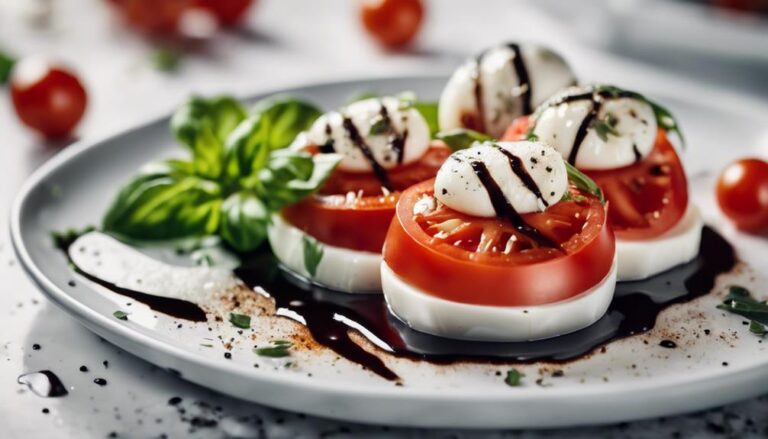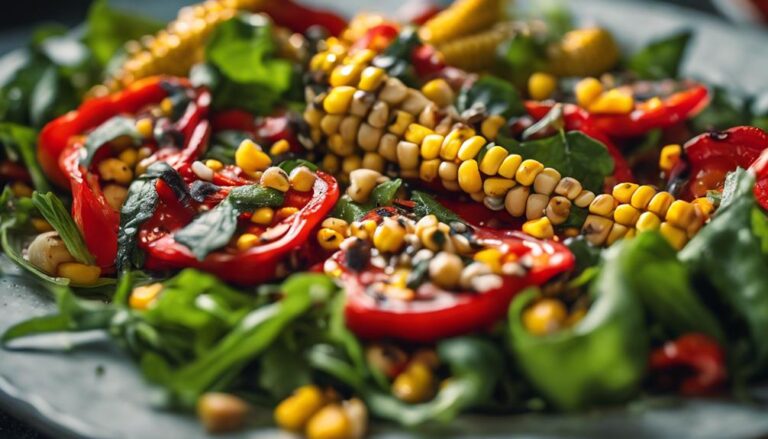Soup Sous Vide Roasted Red Pepper Gazpacho
Step into the world of culinary sophistication with a tantalizing exploration of Soup Sous Vide Roasted Red Pepper Gazpacho. Discover how this innovative approach elevates traditional gazpacho to new heights, offering a symphony of flavors that will leave your taste buds craving for more. As you savor each spoonful of this meticulously crafted soup, you'll uncover the secrets behind its velvety texture and unparalleled depth of taste. Stay tuned to unravel the mysteries of sous vide techniques and how they transform this classic dish into a culinary masterpiece.
What You Will Learn Here
- Sous vide method enhances flavors and texture in roasted red pepper gazpacho.
- Vacuum sealing preserves freshness and intensifies flavors in the soup.
- Slow cooking allows for better flavor development and tenderizes ingredients.
- Garnish with fresh herbs and drizzle olive oil for a visually appealing presentation.
- Experiment with ingredient substitutions for a personalized touch to the traditional gazpacho recipe.
Origin of Gazpacho

Gazpacho has deep roots in Spanish culinary traditions, tracing back to the Andalusian region. Over time, this chilled soup has evolved, with variations incorporating different ingredients and flavors.
In modern cuisine, gazpacho has become a popular dish enjoyed for its invigorating taste and versatility.
Gazpacho's Spanish Roots
Originally hailing from the southern region of Spain, this invigorating soup has deep roots in Andalusian cuisine. Gazpacho, a traditional Spanish dish, is a cold soup made from fresh vegetables like tomatoes, peppers, cucumbers, and garlic. Its origins date back to the time when Spain was under Moorish rule, showcasing the influence of diverse cultural interactions on Spanish culinary traditions. Gazpacho holds significant cultural importance in Spain, not just for its revitalizing taste but also for its symbolic representation of utilizing local produce and simple ingredients to create a flavorful dish.
Within Spanish culinary traditions, gazpacho stands out as a staple dish during hot summers, offering a cool and invigorating escape from the scorching Andalusian sun. Its preparation method aligns with the emphasis on using fresh, seasonal ingredients that are abundant in the region.
Over time, gazpacho has become emblematic of Spanish cuisine, reflecting a harmonious blend of flavors and textures that celebrate the essence of Andalusian gastronomy.
Evolution of Gazpacho
Explore how the evolution of gazpacho, deeply rooted in Andalusian cuisine, has influenced the modern interpretation of this iconic dish. Gazpacho's journey showcases a blend of cultural influences that have shaped its evolution over centuries. Originating as a humble peasant dish in southern Spain, gazpacho has transformed into a beloved culinary symbol of Spanish gastronomy.
The variations of gazpacho reflect the cultural diversity it has encountered. From traditional tomato-based recipes to innovative twists like watermelon or almond gazpacho, the dish has adapted to global palates while maintaining its essence. The introduction of new ingredients and techniques has expanded the possibilities of this invigorating soup, allowing for creative interpretations worldwide.
Global adaptations have further enriched the gazpacho experience. As the dish traveled beyond Spain, it absorbed culinary influences from different regions, resulting in unique interpretations that honor both tradition and innovation. The evolution of gazpacho continues to develop, reflecting the dynamic nature of culinary traditions in a globalized world.
Gazpacho in Modern Cuisine
In modern cuisine, the origins of gazpacho can be traced back to the traditional peasant dishes of southern Spain. This cold soup, typically made from tomatoes, peppers, cucumbers, onions, garlic, and bread, has evolved from its humble beginnings into a versatile dish that can be found in restaurants worldwide.
Gazpacho has seen a resurgence in popularity due to its invigorating taste and health benefits. Packed with vitamins, minerals, and antioxidants, this soup isn't only delicious but also a nutritious addition to any diet. Its low-calorie content and high water content make it a great option for those looking to stay hydrated and satisfied.
Moreover, chefs have been experimenting with gazpacho fusion dishes, incorporating unique ingredients and flavors to put a modern twist on this classic recipe. From watermelon gazpacho to avocado gazpacho, the possibilities are endless when it comes to reinventing this traditional dish for contemporary palates.
Whether enjoyed as a starter or a light meal, gazpacho continues to captivate food enthusiasts with its rich history and adaptability in today's culinary landscape.
Key Ingredients for Gazpacho
Consider selecting ripe tomatoes, cucumbers, bell peppers, and red onions as the key ingredients for your delicious Gazpacho. These ingredients form the traditional base of this Spanish cold soup, providing a revitalizing and vibrant flavor profile perfect for warm days. When choosing these items, aim for the freshest produce available to enhance the overall taste of your Gazpacho.
To create a flavorful Gazpacho, make sure you have the following key ingredients on hand:
- Ripe Tomatoes: Choose ripe, juicy tomatoes for that sweet and tangy flavor.
- Cucumbers: Crisp cucumbers add an invigorating crunch to the soup.
- Bell Peppers: Vibrant bell peppers bring a subtle sweetness and color to the Gazpacho.
- Red Onions: Red onions provide a mild sharpness that complements the other ingredients perfectly.
While these ingredients form the traditional base, feel free to experiment with Gazpacho ingredient substitutions and variations to personalize your soup to suit your taste preferences.
Trending Gazpacho Variations
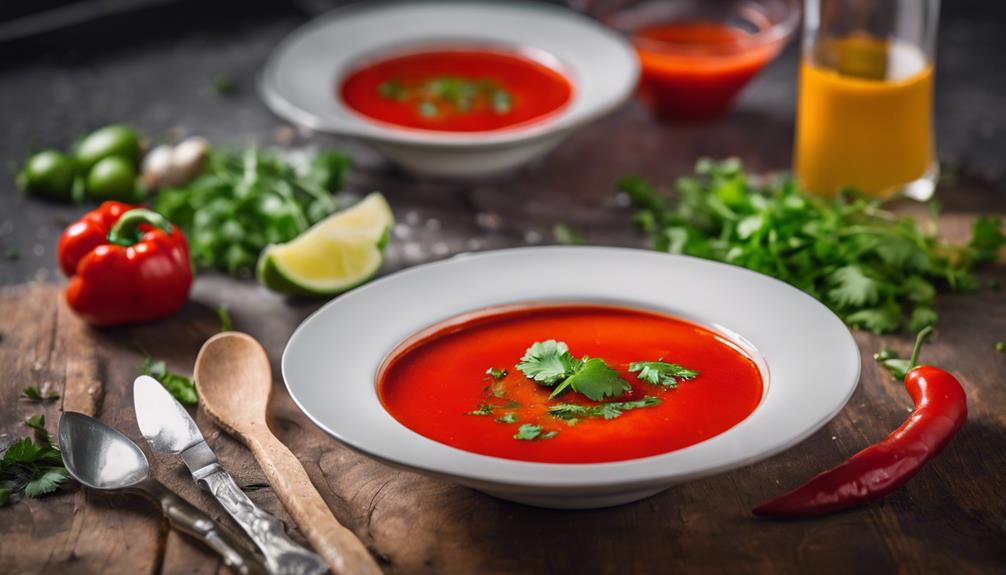
Explore the current trends in gazpacho with innovative variations like Sous Vide Gazpacho With Peppers.
Sous Vide Chilled Cucumber Gazpacho offers a refreshing twist on the classic cold soup.
Try Sous Vide Chilled Tomato Gazpacho for another unique take on this traditional dish.
These modern interpretations blend flavors in exciting new ways, perfect for expanding your culinary repertoire.
Embrace the versatility of gazpacho with these invigorating options that offer a fresh perspective on a beloved dish.
Sous Vide Gazpacho With Peppers
To elevate your gazpacho game, try incorporating sous vide cooking technique to infuse the peppers with intense flavor. This method allows for a deep infusion of flavors, enhancing the overall taste profile of your gazpacho.
Here are some tips to help you master the art of sous vide gazpacho with peppers:
- Precise Temperature Control: Sous vide cooking guarantees that the peppers are cooked at a consistent temperature, allowing them to release their natural juices and flavors slowly.
- Extended Infusion Time: With sous vide, you can let the peppers infuse in their own juices for an extended period, intensifying the flavors that will eventually blend into your gazpacho.
- Experiment with Different Pepper Varieties: Try using a mix of sweet and spicy peppers to create a complex flavor profile in your gazpacho.
- Balancing Ingredients: Adjust the seasoning and acidity levels in your gazpacho to complement the rich flavors that sous vide peppers bring to the dish.
Sous Vide Chilled Cucumber Gazpacho
For a invigorating twist on traditional gazpacho, try preparing a sous vide chilled cucumber gazpacho that's bursting with vibrant flavors. Here's how you can elevate this classic dish:
- Flavorful Variations: Experiment with adding fresh herbs like dill or mint to enhance the invigorating taste of the cucumber gazpacho.
- Innovative Presentation: Serve the gazpacho in small shot glasses for a stylish appetizer at your next gathering.
- Ingredient Substitutions: Swap out some of the cucumbers for green apples to introduce a subtle sweetness to the dish.
- Unique Textures: For added texture, top your gazpacho with a sprinkle of toasted pine nuts or croutons for a delightful crunch.
Sous Vide Chilled Tomato Gazpacho
Consider infusing a modern twist into your gazpacho repertoire with a rejuvenating sous vide chilled tomato gazpacho. This chilled soup, prepared using sous vide techniques, offers a delightful variation on the classic tomato gazpacho. Here are some key aspects to keep in mind when preparing this trendy dish:
- Flavorful Tomatoes:
Opt for ripe, flavorful tomatoes to enhance the taste of your gazpacho. The quality of the tomatoes greatly impacts the final dish.
- Balanced Seasonings:
Experiment with a blend of seasonings like garlic, onion, and a hint of vinegar to achieve a balanced flavor profile that complements the sweetness of the tomatoes.
- Texture Play:
Consider adding in diced cucumber or bell peppers for a contrasting texture that adds depth to your gazpacho.
- Garnish Creatively:
Elevate your presentation by garnishing with fresh herbs like basil or a drizzle of high-quality olive oil to enhance the visual appeal and flavor complexity of your sous vide chilled tomato gazpacho.
Sous Vide Preparation Techniques
When considering Sous Vide preparation techniques, it's essential to acknowledge the benefits they offer.
With precise temperature control, you can achieve perfect doneness every time. Vacuum sealing helps retain flavors and juices, while slow cooking can enhance the tenderness and taste of your dishes.
Precise Temperature Control
Achieving precise temperature control in sous vide preparation techniques is essential for ensuring consistent and perfectly cooked results. Temperature accuracy plays a vital role in the sous vide method, where ingredients are vacuum-sealed and cooked in a water bath at a specific temperature for an extended period. This cooking precision allows for even cooking throughout the food, resulting in a uniform texture and ideal doneness.
By maintaining a precise temperature, you can control the level of doneness with great accuracy. Whether you prefer your meat rare, medium, or well-done, sous vide cooking enables you to achieve the perfect outcome every time. The controlled temperature also helps retain the natural juices and flavors of the ingredients, creating a more flavorful end product.
With sous vide cooking, you have the advantage of setting the water bath to the exact temperature needed for your recipe, ensuring that your food is cooked precisely and consistently. This method is particularly beneficial for delicate dishes like the Roasted Red Pepper Gazpacho, where maintaining the integrity of the ingredients is key to achieving a delicious result.
Vacuum Sealing Benefits
Vacuum sealing in sous vide preparation techniques enhances flavor retention and guarantees consistent cooking results. When you vacuum seal your ingredients before sous vide cooking, you lock in freshness and prevent any flavors from escaping during the cooking process. This method not only extends the shelf life of your food but also ensures that the taste remains intact until you're ready to enjoy your meal.
The benefits of vacuum sealing go beyond just preserving flavor. By removing the air from the cooking pouch, you create a perfect environment for the ingredients to cook evenly and retain their natural juices. This results in dishes that aren't only flavorful but also incredibly tender and moist.
When you vacuum seal your ingredients for sous vide cooking, you're setting yourself up for success in the kitchen. The process may require a bit of extra time and effort, but the payoff with regard to flavor retention and consistent cooking results is well worth it.
Slow Cooking Advantages
To enhance your sous vide preparation techniques, consider the advantages of slow cooking in maintaining the integrity of flavors and textures in your dishes. Slow cooking in sous vide not only tenderizes tough cuts of meat but also allows flavors to develop more fully over time.
One of the key advantages of this technique is the precise control over temperature, ensuring that your ingredients are cooked evenly without the risk of overcooking. By cooking your ingredients at a consistent low temperature for an extended period, you can achieve a perfect balance of tenderness and flavor infusion that's hard to replicate with other cooking methods.
Additionally, slow cooking in sous vide helps to preserve the natural juices and aromas of your ingredients, resulting in dishes that are more flavorful and succulent. The gentle cooking process also helps to break down tough connective tissues in meats, making them incredibly tender while retaining their natural juices.
Final Thoughts
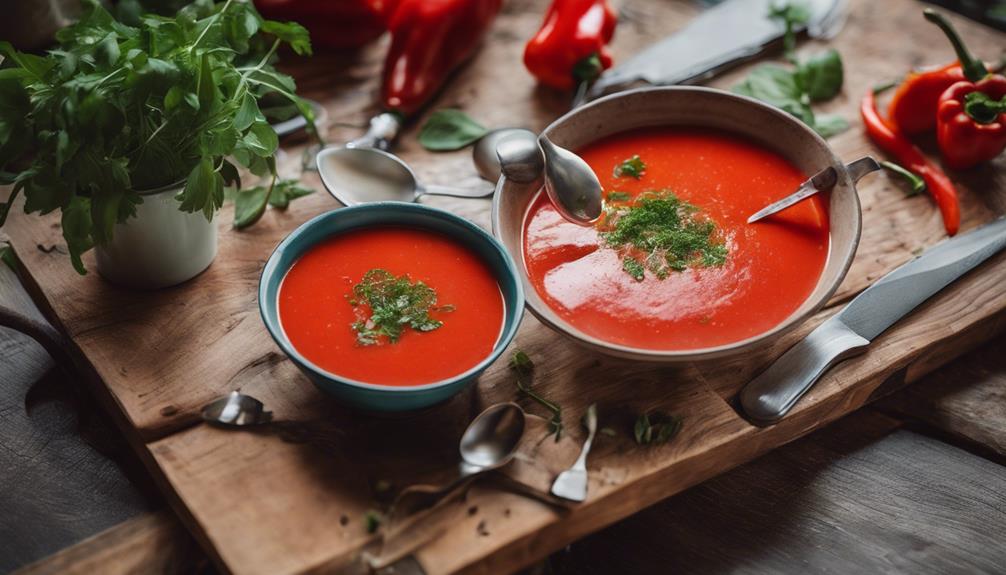
Consider incorporating some fresh herbs or a drizzle of olive oil to enhance the flavors of your roasted red pepper gazpacho. Experiment with flavor combinations like adding a touch of basil or cilantro for a rejuvenating twist, or a sprinkle of smoked paprika for depth. These additions can elevate the taste profile of your gazpacho and make it even more enjoyable.
When it comes to presentation techniques, serving your gazpacho in chilled bowls or glasses can enhance the invigorating experience. You can garnish with a swirl of cream, a sprinkle of finely chopped red peppers, or a few croutons for added texture.
For ingredient substitutions, if you're looking to switch things up, consider using yellow or orange bell peppers instead of red for a different flavor profile. You can also experiment with adding roasted tomatoes or cucumbers to create a unique variation of this classic soup.
As for serving suggestions, pair your roasted red pepper gazpacho with a side of crusty bread, a light salad, or even some grilled shrimp for a complete and satisfying meal. Enjoy the vibrant flavors and revitalizing sensation of this delightful soup!
Frequently Asked Questions
Can I Adjust the Spiciness Level of the Roasted Red Pepper Gazpacho?
You can easily adjust the spiciness level of the roasted red pepper gazpacho by adding more or less red pepper flakes or adjusting the amount of jalapenos. This simple tweak allows for personalized flavor variations.
How Long Can I Store the Gazpacho in the Refrigerator?
You can store your gazpacho in the refrigerator for up to 3-4 days. To preserve flavor, keep it sealed in an airtight container. Check for any changes in color or smell before consuming for best freshness.
Are There Any Garnish Recommendations to Enhance the Gazpacho?
For garnish ideas, consider topping your gazpacho with fresh herbs like basil or cilantro, a drizzle of olive oil, and a sprinkle of croutons for added texture. These flavor combinations enhance your dish beautifully.
Can I Substitute Red Peppers With Other Vegetables in the Recipe?
For vegetable substitutions in recipes, consider ingredient variations to suit taste preferences. Customize flavors by swapping red peppers for other veggies. Experiment with bell peppers, tomatoes, or cucumber to create a unique twist on the dish.
Is It Possible to Make the Gazpacho Ahead of Time and Freeze It?
Yes, you can make gazpacho ahead and freeze it. Freezing may alter the texture slightly, but flavor should be preserved. Thaw in the fridge for best results. Stir well before serving to refresh the consistency.
Conclusion
To sum up, soup sous vide roasted red pepper gazpacho is a delightful and innovative dish that combines the smoky sweetness of roasted red peppers with the freshness of ripe tomatoes.
Utilizing sous vide techniques guarantees a consistently delicious and perfectly cooked soup every time.
With a drizzle of olive oil and fresh basil to garnish, this gazpacho is a sensory delight that showcases the art of precision cooking and flavor enhancement.
Enjoy this vibrant and velvety soup for a truly satisfying culinary experience.
